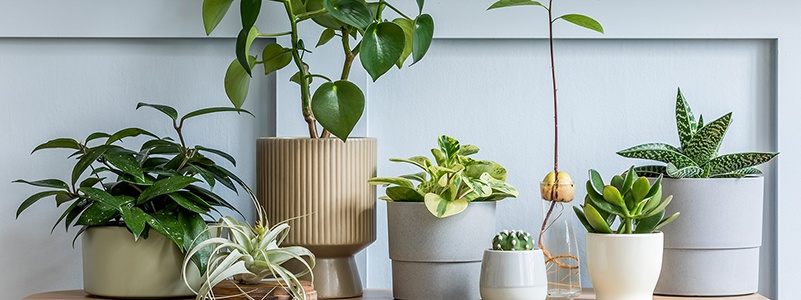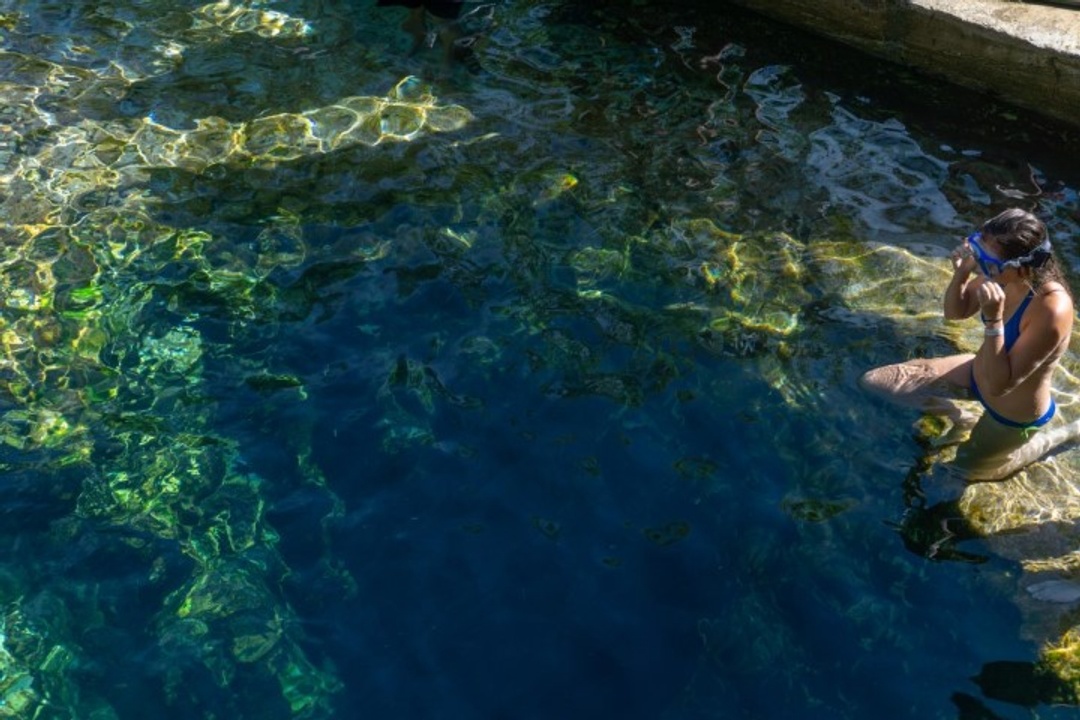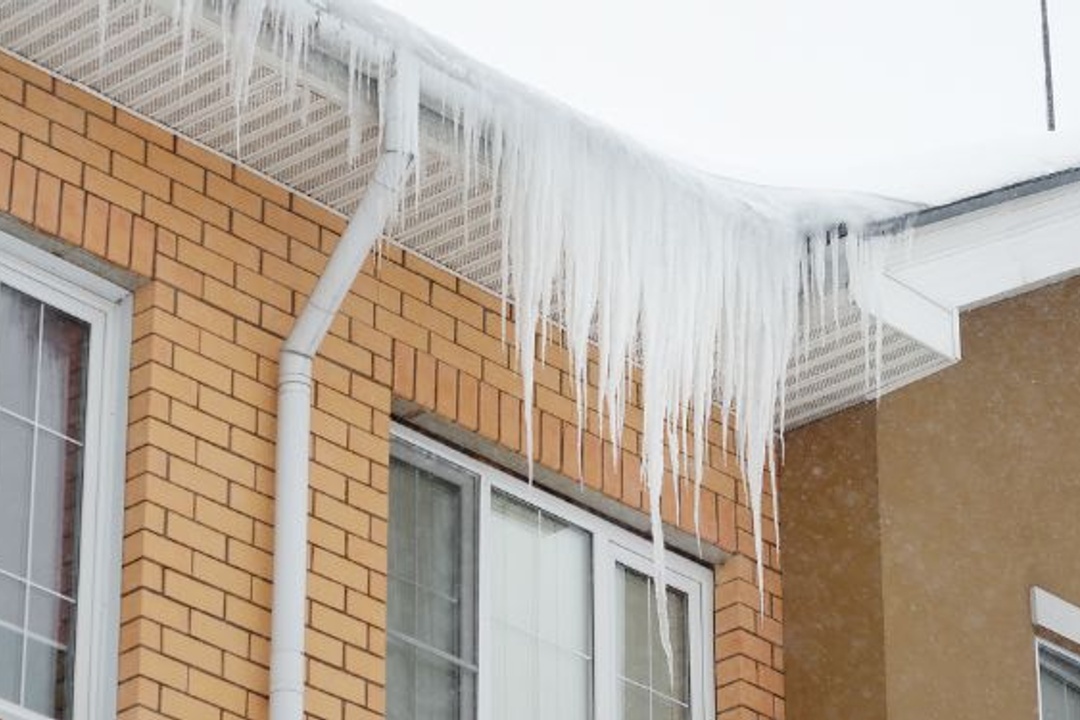
Some plants are perfectly safe for your cat or dog but others can cause serious ill effects. If you’re worried that your pet has found exposure to a plant that is harmful, contact the Animal Poison Control Center.
To keep your pet safe from potentially toxic houseplants, check out this list for 20 pet safe houseplants and 10 common but toxic houseplants.
1. Spider Plant

Cholorphytum comosum, commonly known as the spider plant or spider ivy is an easy to grow houseplant. People love these plants because they can tolerate a lot of bad gardening and continue to thrive.
Safe For: Dogs and Cats
Care Tip: Noticing browning on the leaves of your spider plant? Don’t worry, this is actually quite common and will not harm your plant. Often the cause of browning leaves is fluoridated water from the tap. To fix this use rainwater or distilled water to water your spider plant.
2. Watermelon Plant

The watermelon plant or aluminum plant’s scientific name is Pilea Cadieri. This North African plant has made its way into the homes of many houseplant enthusiasts not only because of its beauty but also because it is simple to please. Watermelon plants don’t need a lot of bright light to thrive making them great for the indoors.
Safe For: Dogs and Cats
Care Tip: This plant doesn’t do well in arid climates. If your home is overly dry (either because of your heat use in the winter months or the general humidity of your location) make sure to mist the leaves with plain water every other day.
3. American Rubber Plant

Peperomia obtusifolia, better known as the American rubber plant is native to Mexico, the northern parts of South America, and the West Indies. This plant is a fan favorite because it is a low maintenance plant great for homes where placement in direct sunlight is difficult.
Safe For: Dogs and Cats
Care Tip: If your plant isn’t thriving it may be due to overwatering. American rubber plants need water but not too much. Allow the soil to almost dry before rewatering for the longest life.
4. Zebra Plant

The zebra plant, also known as the zebra haworthia is a succulent native to South Africa. Haworthiopsis attenuata is often mistaken for other succulents but can best be distinguished by its bumpy leaf surfaces while others are smooth to the touch.
Safe For: Dogs and Cats
Care Tip: Noticing some problems with your zebra plant during the winter months? You’re probably watering it too much. To give this plant its best chance to thrive, make sure you only water it once a month during the winter.
5. Boston Fern

Nephrolepis exalta bostoniesis is a plant native to Florida, Central and South America, and a few other areas. While the Boston fern houseplant can be grown outdoors, it makes an excellent indoor hanging houseplant. People love the Boston fern because of its lush green leaves.
Safe For: Dogs and Cats
Care Tip: If you happen to see any dark brown or black dots on the underside of the leaves in a pattern don’t be worried. The Boston fern produces spores on the underside of their leaves occasionally, these are not bugs or disease.
6. Dwarf Palm

Commonly known as the dwarf palm, parlor palm, and good luck palm, the Charmaedorea elegans is one of the most sought out houseplants. People love the parlor palm because not only is it a low-cost plant, it is very resilient and an excellent plant for beginner houseplant collectors.
Safe For: Dogs and Cats
Care Tip: If you’re worried about killing your plant, don’t be. The parlor palm is practically unkillable. However, to avoid root rot and fungus, make sure that when you water the good luck palm you remove any excess water from the drip tray.
7. Thimble Cactus

The mammalian gracilis or thimble cactus is a beautiful Central Mexican succulent. Many houseplant enthusiasts love the thimble cactus because during its blooming season, typically the summer, you can see some of the prettiest little yellow or cream-colored flowers.
Safe For: Dogs and Cats
Care Tip: This plant goes dormant in the cooler winter months. When this happens make sure that you cease watering your thimble cactus. You should; however, mist the plant occasionally. Also, do not fertilize your plant during its dormant time period, it is unnecessary.
8. Scarlet Star Plant

While it can take up to four years to get a scarlet star or bromeliads to its mature blooming stage, it’s well worth the wait. The guzmania lingulata when in bloom, which it only does once in its life, is a deep scarlet red and is shaped like a star giving it its name.
Safe For: Dogs and Cats
Care Tip: When watering your scarlet star, be careful, this plant is finicky when it comes to water. Never use tap water to water this plant, only use rainwater or distilled water, as the chemicals in your tap water might kill the plant.
9. Sage

Looking to grow some herbs as houseplants? Sage can be one great plant to grow in your home. Salvia officialis, its scientific name, blooms in early summer with lavender to pink-colored flowers. While there are hardier varieties of the sage plant, this one can offer some of the most beautiful aesthetics.
Safe For: Dogs and Cats
Care Tip: Sage needs a lot of sunlight to grow properly. So make sure that you give your plant ample amounts of sun. You can place it in a window box or use artificial grow lights to help this plant grow robustly.
10. Hens and Chickens

Urbinia agavoides also known as hens and chickens or echeveria elegans is a common succulent houseplant that grows in rosette-shaped clumps. This plant is native to both Northeastern Mexico and Southern California. While rare, hens and chickens do bloom and have beautiful reddish-pink flowers.
Safe For: Dogs and Cats
Care Tip: Do not overwater your urbinia agavoides because they do not tolerate lots of water. For best results use a soak and then dry watering schedule. This means you soak the plant and do not rewater until the soil is mostly dry.
11. Areca Palm

Also known as the butterfly palm and golden cane palm, the areca palm is a large indoor houseplant that can grow up to 12 feet in height. Houseplant enthusiasts love the dypsis lutescens because of its beautiful feathery leaves and its very tropical appearance.
Safe For: Dogs and Cats
Care Tip: This plant is not a good first houseplant, as it doesn’t tolerate being neglected. The areca palm requires lots of bright, indirect sunlight and always moist but never soggy soil. To help maintain the water flow, try a self-watering pot.
12. Kentia Palm

Looking for a palm that’s just a beautiful as the areca but doesn’t require nearly as much care? Then the kentia palm is perfect for you. The howea forsteriana is known by houseplant lovers for its ability to withstand conditions that most houseplants can not tolerate. The kentia is a native of the South Pacific but can thrive in indoor settings, growing up to 12 feet high in a container.
Safe For: Dogs and Cats
Care Tip: While kentia palms can adapt to a wide range of soil, they prefer to be grown (when in containers) in a well-draining potting mix a little on the sandy side. Do not overwater the plant, only water when the top inch of soil is starting to dry out.
13. Lace Flower Vine

The episcia dianthiflora, commonly known as the lace flower vine is a plant native to Central and South America. This houseplant is widely loved by plant lovers because of its fringe-edged petals that trail along making it perfect for hanging baskets. It is also well-loved because of its large white frilled flowers.
Safe For: Dogs and Cats
Care Tip: The lace flower vine is adaptable to home conditions but does require some warmth and humidity to thrive. To keep it growing at its best, try keeping this plant under artificial light or on a windowsill.
14. Lady Palm

Add a little drama to your life with a lady pam or rhapis exelasa. The lady palm has fan-shaped green and glossy leaves that grow sort of like a shrub. At its maturity, it typically gets up to six-feet tall and four-feet wide when planted in a container indoors. This plant is a fan favorite because its care isn’t overly complex.
Safe For: Dogs and Cats
Care Tip: While caring for a lady palm isn’t complicated, there are some key tips to remember. Lady palms do best in indirect sunlight, direct light can cause the leaves to burn. Also, remember to only water when the top inch of soil feels dry.
15. Old Man Cactus

Scientifically known as the cephalocereus senilis, the old man cactus is one of the most popular and identifiable members of the cactus family. It is native to Mexico, specifically Guanajuato and Hidalgo. While the old man cactus can easily be grown outside in hot, dry climates, most people prefer this succulent as a houseplant.
Safe For: Dogs and Cats
Care Tip: A glazed planter might look nice to hold your old man cactus but they should be avoided. Glazed pots will keep in the moisture adding to rot and disease. For best soil conditions, choose an unglazed pot.
16. Dallas Fern

Also known as the bold sword fern, the nephrolepsis biserrata is a houseplant that will look amazing in a hanging basket in your home. The Dallas fern is a native species to thousands of tropical areas worldwide but is loved as a houseplant because they are very drought resistant and look graceful in a home.
Safe For: Dogs and Cats
Care Tip: Want to keep your Dallas fern looking perfect? Make sure to keep your indoor temperatures somewhere between 55 and 75 degrees Fahrenheit. That shouldn’t be too difficult to achieve as most people prefer these temperature ranges as well. But be careful leaving these ferns in windows overnight during the winter months, as temperatures may dip well below their acceptable range.
17. Rosemary

Many people love planting little herb gardens inside their homes and rosemary or rosmarinus officinalis is often a common staple. They are a beautiful and fragrant houseplant to keep and are versatile. They aren’t just great to look at, they work great for creating toiletries and cooking with meats and vegetables.
Safe For: Dogs and Cats
Care Tip: Rosemary is very tolerable to a variety of soils and light conditions but prefers sandy, slightly acidic, and well-drained soil with lots of sun. Once your plant is established it should be fairly drought resistant as well.
18. Candle Plant

Plectranthus coleoides is a beautiful green and white ivy-like plant and is also known as the candle plant or Swedish ivy. What’s great about this plant is that for flower-loving houseplant enthusiasts, this plant often blooms with beautiful little purple flowers.
Safe For: Dogs and Cats
Care Tip: The candle plant is a hardy houseplant and looks great in a container or hanging basket. When planting the Swedish ivy in a container make sure to place it in a spot that gets at least partial sun for best results.
19. Easter Orchid

The Easter orchid or cattleya mossiae is a pinkish-purple flowering orchid that is native to Northern Venezuela. It is one of the most beautiful orchids in the cattleya species and has a wonderful fragrance and large flowers. They typically flower in the springtime.
Safe For: Dogs and Cats
Care Tip: Unlike many orchids, fertilizer is not needed for the Easter orchid to produce good growth or flowers. If you do fertilize this plant, it should be done weekly during the active growth period, typically between August and September. Also, remember to never use slow-release fertilizers as they can release during dormant periods and damage the plant.
20. Common Zinnia

While there are many subtypes of zinnias, the most common is the common zinnia or zinnia elegans. These are annual plants but can be grown inside the home. It typically flowers in the summer months adding a much-needed pop of color to the home.
Safe For: Dogs and Cats
Care Tip: Common zinnias are fairly easy to care for but do require lots of sun to thrive. In addition to their need for ample sunlight, make sure to keep the soil of your zinnia moist for best results.
H2: Plants Toxic to Pets
There are some plants you should avoid having in the home because they are toxic to pets. If you do have these, ensure they are kept well out of reach of all pets so that pets do not accidentally ingest them. Some toxic plants to watch out for include...
21. Aloe Vera

Aloe may have tons of wonderful uses for humans. With purported health benefits like heartburn relief and skincare, many people are looking to grow aloe vera in their homes to make use of a naturally grown supply. However, for pet owners, aloe can be very harmful to both dogs and cats.
Toxic For: Dogs and Cats
Exposure Effects: If your beloved pet is exposed to aloe vera, you may notice vomiting, lethargy, and diarrhea.
22. Peace Lily

The spathiphyllum or peace lily is yet another common houseplant that is toxic to both cats and dogs. This beloved plant is well-loved for its beauty and its indoor air pollutant removal properties.
Toxic For: Dogs and Cats
Exposure Effects: The peace lily has insoluble calcium oxalates that will cause oral irritation, intense burning of the mouth, tongue, and lips. It can also cause excessive drooling, vomiting, and difficulty swallowing.
23. Parsley

While you might want to start a little herb garden in your home if you do be sure to steer clear of parsley or petroselinum crispum. This common herb is unfortunately toxic to both dogs and cats.
Toxic For: Dogs and Cats
Exposure Effects: In large doses, the furanocoumarins present in parsley can cause extreme photosensitization leading to sunburn and dermatitis in dogs and cats.
24. Tulips

If you love decorating your home with flowers, Tulips might seem like a sensible choice. However, think again if you have dogs or cats. While the common tulip or tulipa spp is a beautiful flower to grow in a pot inside your home, these flowers can be very toxic to both dogs and cats.
Toxic For: Dogs and Cats
Exposure Effects: The tulipalin A and B found in tulips can cause vomiting, diarrhea, hypersalivation, and depression in dogs and cats. The highest concentration of these toxic chemicals are found in the bulbs.
25. Philodendrons

Philodendrons are a large collection of over 500 different species of plants that are native to the tropical Americas and the West Indies. While this climbing plant can be beautiful to have in a hanging planter in your home, it can be toxic to your family pet.
Toxic For: Dogs and Cats
Exposure Effects: Due to the presence of insoluble calcium oxalates, philodendrons can cause oral irritation, pain, and swelling in both dogs and cats. Other associated problems include excessive salivation, vomiting, and difficulty swallowing.
26. Pothos

Also known as golden pothos, devil’s ivy, taro vine, and ivy arum, epipremnum aureum is another popular houseplant that contains elements toxic to your cats or dogs. While beautiful, pet owners should choose a different ivy as these can be devilish to the animals you love and care for.
Toxic For: Dogs and Cats
Exposure Effects: If your beloved dog or cat ingests a pothos plant they may have any or all of the following symptoms: oral irritation, burning of the mouth, excessive drooling, vomiting, or difficulty swallowing.
27. Jade Plants

The crassula argentea is well known by houseplant enthusiasts as the jade plant, Japanese rubber plant, or dwarf rubber plant. This succulent is popular because it thrives in low light but unfortunately, for pet owners, this plant will be a danger to your cat or dog.
Toxic For: Dogs and Cats
Exposure Effects: While the exact toxic chemical is hard to pinpoint, the jade plant can cause vomiting, depression, and a loss of coordination for your loved pet if ingested.
28. Swiss Cheese Plant

The monstera deliciosa may have a scientific name that suggests deliciousness but the mother-in-law plant or Swiss cheese plant is anything but delicious for your favorite cat or dog. This plant, native to Southern Mexico is a popular houseplant for its unique leaves but is best for homeowners without pets.
Toxic For: Dogs and Cats
Exposure Effects: Due to the presence of calcium oxalate crystals the Swiss cheese plant will cause irritation and intense burning of the mouth, lips, and tongue of your pet. It can also cause excessive drooling, vomiting, and difficulty swallowing.
29. Snake Plant

Sanseviera trifasciata, also known as the snake plant, good luck plant, and golden bird’s nest is another highly popular houseplant that is toxic to both cats and dogs. Popular due to its low-maintenance needs, this plant is better suited for petless houseplant enthusiasts.
Toxic For: Dogs and Cats
Exposure Effects: The presence of saponins in the snake plant can cause your family pet to become nauseous. This plant can also cause vomiting and diarrhea.
30. English Ivy

The English Ivy or hedera helix is a sometimes aggressive vine that many houseplant enthusiasts love to grow in their homes in pots. However, while this ivy is easy to care for and works well in the home environment, it can be exceptionally bad for your pet.
Toxic For: Dogs and Cats
Exposure Effects: English ivy has hederagenin or triterpenoid saponins within it. Exposure to this chemical by dogs and cats can cause vomiting, abdominal pain, hypersalivation, and diarrhea. Keep in mind the foliage is more toxic than the berries.
If your plant collection is getting out of hand and you need more space, it might be time for a bigger home for you, your pets, and your plants. Check out Better Homes and Gardens Real Estate: HomeCity for your dream home today.











